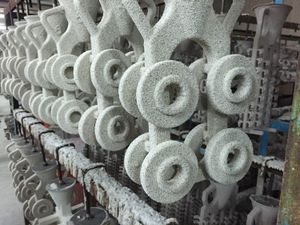Ah, Friday: A time to either kill the tabs or write ‘em up.
SCOPE CREEP.
- It’s funny: For years, the top clicked link in this newsletter would be, like, a video of a bunch of CNC machines, or an explainer on why U-shaped factory layouts are so great. But recently more of you have clicked on blog posts, written by yours truly, cataloging the books I’ve been reading. This no doubt has to do with the way I’ve structured the emails themselves, and the prominent locations at which I’ve been linking to these blog posts, and also to the fact that I’ve added paywalls into so many recent issues of this newsletter. Nevertheless, it feels like a signal of… something. So anyway, here’s my media diet right now:
In print, I’m currently working through W. Somerset Maugham’s Of Human Bondage, Isaac Deutscher’s The Non-Jewish Jew (which I may not finish, and which you can read the meatiest portion of here, on marxists.org 👀), Maylis De Kerangal’s Birth of a Bridge, and Joan Didion’s The White Album. On audio, I’m currently reading Jonathan Safran Foer’s Eating Animals (which I find artful, persuasive, and emotionally compelling) and George Saunders’ A Swim in a Pond in the Rain. This last book is essentially an MFA course in Russian short stories: A story (by Chekhov, Turgenev, Tolstoy, and Gogol) is read in full, and then Saunders hops in with an essay/lecture about the story and observations on the story-writing process. The format is captivating, and the stories are pretty fantastic too; I especially liked Gogol’s The Nose, which you can read in full in this PDF.
Uh, what else… I’m casually watching and enjoying 3 Body Problem, enjoyed both Poor Things and Past Lives, will eventually finish rewatching Zhang Yimou’s epic To Live, and choked up a little rewatching On Golden Pond on a sick day last week.
- A quick status check on the state of NYC Subway service: In January 2018 weekday on-time performance was 58.1%; last month it was 80.6%. So, great, the MTA is doing a much better job sticking to their rush hour schedules; but have their schedules gotten more lax in the meantime, making it easier for them to deliver “good” service but resulting in worse service nonetheless?
At a little under thirty million miles traveled per month systemwide, the MTA is delivering basically the same quantity of subway transportation now as they were in 2018 (see here and toggle the Metric field to “total miles”). And their subway cars seem to be working reasonably well too: The mean distance a car travels between failures (around 100,000 miles; toggle the Metric field to “MDBF”) is essentially the same as it was in 2018. I reached out to the MTA to see how their weekday scheduling has changed since 2017 – how many cars per hour, for instance, are running on each line during peak hours – but all they told me was that “this type of data is not available.” This very comprehensive blog post, though, suggests that off-peak (night & weekend) scheduling has gotten significantly worse due to schedule padding. - If you’re thinking about looking at the solar eclipse in a week and a half, the ISO spec you should be thinking about is 12312-2:2015, which covers eye protection “for direct observation of the sun.” According to the American Astronomical Society’s Solar Eclipse Task Force, 12312-2 was written largely by one Ralph Chou, a now-retired professor at the University of Waterloo who is apparently “the world’s leading expert on safely viewing solar eclipses.” 12312-2 was published in 2015 and confirmed in 2020, but in 2021 Chou et al published a paper in the Astronomical Review which aimed “to assess the appropriateness of [its] provisions.” And they found the standard lacking: Its luminous transmittance ranges had been derived from welding filters, which block more of the blue spectrum than purpose-made eclipse viewing glasses and therefore “do not represent an appropriate evidence base for direct solar viewing.” Chou and his coauthors recommended revising the luminous transmittance values in 12312-2, revising the specified dimensions of the nasal cutaway on cheap cardboard eclipse filters, and also removing the requirement for an “obsolescence date” in the spec, as “solar viewer filters that are stored under controlled conditions for extended periods of time show little, if any, sign of deterioration.”
Anyway: You should still use a 12312-2 filter, and definitely *don’t* take it off and look directly at the sun, and also if you have an old pair of 12312-2 filters then just inspect them for damage before use. Oh, and FYI: The total eclipse will pass from Mazatlán to Dallas to Indianapolis to Montreal; this website shows you its path and lets you simulate what the sun will look like in your city as the moon passes in front of it. - Jane’s Walk is a volunteer-run, do-it-yourself festival where people walk around cities and talk about the communities that live and work there. It is being held on the first weekend of May.
- Here’s a pretty sick 1980s video, thirteen minutes long, about Mitsubishi Heavy Industries’ lineal tube-forming system for electric resistance welded steel tube.
- Here’s a real thing that happened in Canada: Buttergate.
Butter is made of milk fat, not palm oil. This is good; palm oil has a higher melting temperature than butter, and if you mixed a bunch of palm oil into your butter then you’d find it stiff and hard to spread, and if you went to sell the result then you'd need to list “palm oil” as an ingredient, and consumers would probably notice that and avoid your palm-Frankenbutter. So don’t do that! But milk fat is made by cows, and cows can eat palm oil, and if you were a dairy farmer in the early pandemic, and you just culled (killed) a bunch of your cows because schools aren’t buying milk anymore, and you needed some way to produce more butter with fewer cows, then you might feed your cows some palm oil, and they would produce more milk fat, and you could make butter out of it and the only thing on the ingredients list would be “organic cream (milk)” because after all you’re just putting the palm oil in the cows’ feed troughs, not, like, into the butter directly. Cool! But: The butter you churn from this milk fat will be high in palmitic acid, and it’ll have a higher melting temperature than butter usually does, and won’t be very spreadable, and eventually it’ll become a big enough deal on the internet that the Dairy Farmers of Canada will recommend that you quit it with feeding the cows so much palm oil, okay?
Somewhat related, here’s a video of a small-scale butter producer in Brittany, France. I love how, on the kneading machine, “the kneader uses his thumb like a knife [sic] certainly to distribute the material, but it’s also a detection needle. He will feel if there are layers of different textures inside.” Also: “No one should spend the whole day in the same job. If I shape for one hour, I will wrap for one hour, and then I will weigh for one hour. We will keep rotating to not get tired and to stay passionate about what we’re doing.” - Here’s a website that lets you see detailed maps of offshore wind installations, including all of their electrical interconnections.
- Apropos of the note about surface energy in Monday’s newsletter: You can test the energy of your surface with a dyne test marker, which is like a set of go/no-go gauges for adhesion.
Thanks as always to Scope of Work’s Members and Supporters for making this newsletter possible. Thanks also to Nick, Harpo, William, Samantha, TW, Martin, Craig, and AJ for helping source links this week.
Love, Spencer



